Articles on water conservation:
native plants, drought-tolerant ornamentals, how to water, and more
•Australian Plants for Davis Gardens
Davis Enterprise November 12, 2015
•From Brown to Green
Davis Enterprise October 08, 2015
•The Mint Family: great garden plants
Davis Enterprise July 09, 2015
•Watering Questions for Dry Times
Davis Enterprise June 04, 2015
•Blooming Despite the Drought: a garden on 8th Street
Davis Enterprise, April 30, 2015
•Making the Change to Low Water Landscapes
Davis Enterprise April 02, 2015
•Dealing with drought issues in the garden
Davis Enterprise September 11, 2014
•Tips for being smart with water
Davis Enterprise May 08, 2014
•Getting Started with Native Plants!
Davis Enterprise September 12, 2013
How to water less often!
Davis Enterprise July 11 2013
12 Tips for Low Water Gardening
Davis Enterprise November 18 2012
Great Natives for Valley Gardens!
Davis Enterprise November 2012
Lower Water Lawn Options
Davis Enterprise July 2012
Choosing trees to use less water
Davis Enterprise January 2012
Choosing shrubs to use less water
Davis Enterprise November 2011
Easy Steps to Reduced Water Use:
Ground Covers
Davis Enterprise October 2011
Salvias! Ornamental Sages
Lavenders!
Davis Enterprise April 2011
About The Arboretum All-Stars!
Davis Enterprise December 2009
Slowly,
Deeply, Infrequently: How to Water
Davis Enterprise July 2004
Going Native
Davis Enterprise November 2007
Drought Tolerant Plants: a table
What is a Native?
Davis Enterprise March 2009
Succulents and Cactus
Davis Enterprise July 2008
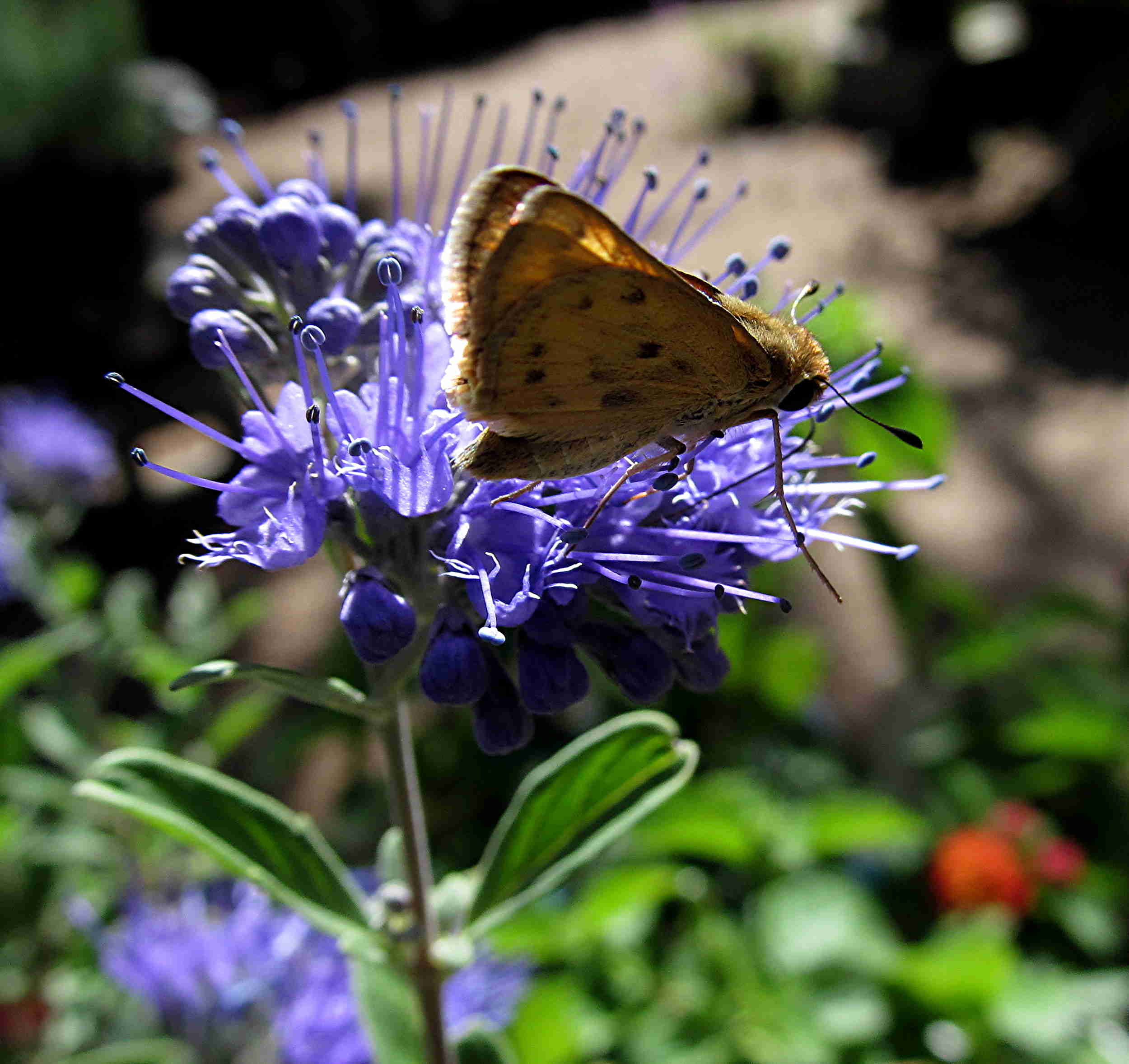
As you choose your low shrubs for low water use, you can also encourage beneficial insects. Bluebeard (Caryopteris x clandonensis) draws butterflies and wild bees to pollinate your garden. This low shrub has grey-green foliage and vivid blue flowers in waves of bloom through the summer. It combines well with rosemary, salvia, and lavender.
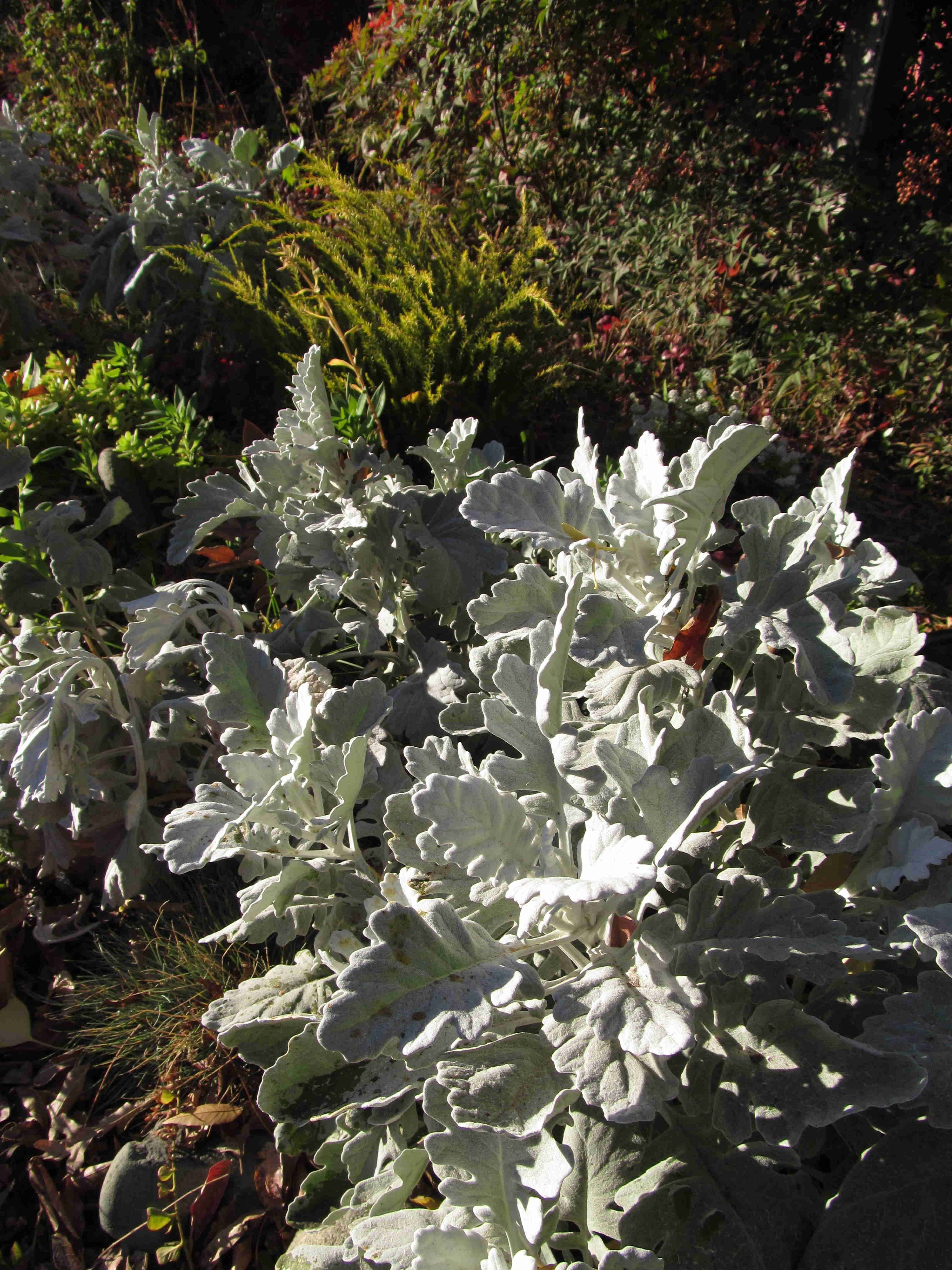 Dusty miller is a common name used for several plants that have woolly white leaves. This one is Senecio cineraria, a Mediterranean native that adapts well to our low-rainfall summers. The foliage contrasts with colorful flowers of other perennials, and lights up a moonlight garden. Very tolerant of drought.
Dusty miller is a common name used for several plants that have woolly white leaves. This one is Senecio cineraria, a Mediterranean native that adapts well to our low-rainfall summers. The foliage contrasts with colorful flowers of other perennials, and lights up a moonlight garden. Very tolerant of drought.
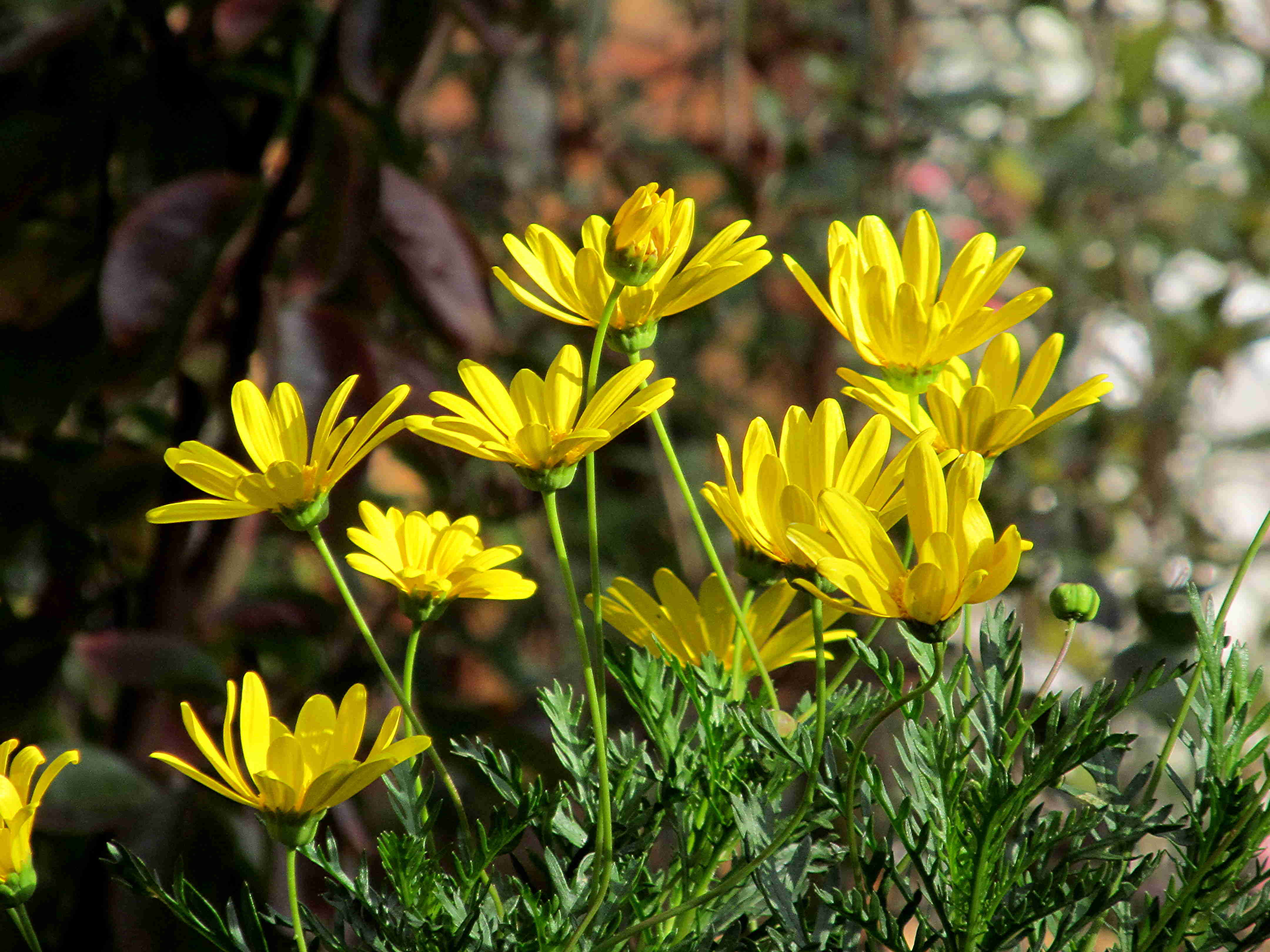 Winter color, low water. Euryops pectinatus, the golden bush daisy, is a shrub to 3 to 4 feet tall and wide. The bright yellow flowers start in October and continue through April. This South African native adapts well to our dry summers.
Winter color, low water. Euryops pectinatus, the golden bush daisy, is a shrub to 3 to 4 feet tall and wide. The bright yellow flowers start in October and continue through April. This South African native adapts well to our dry summers.
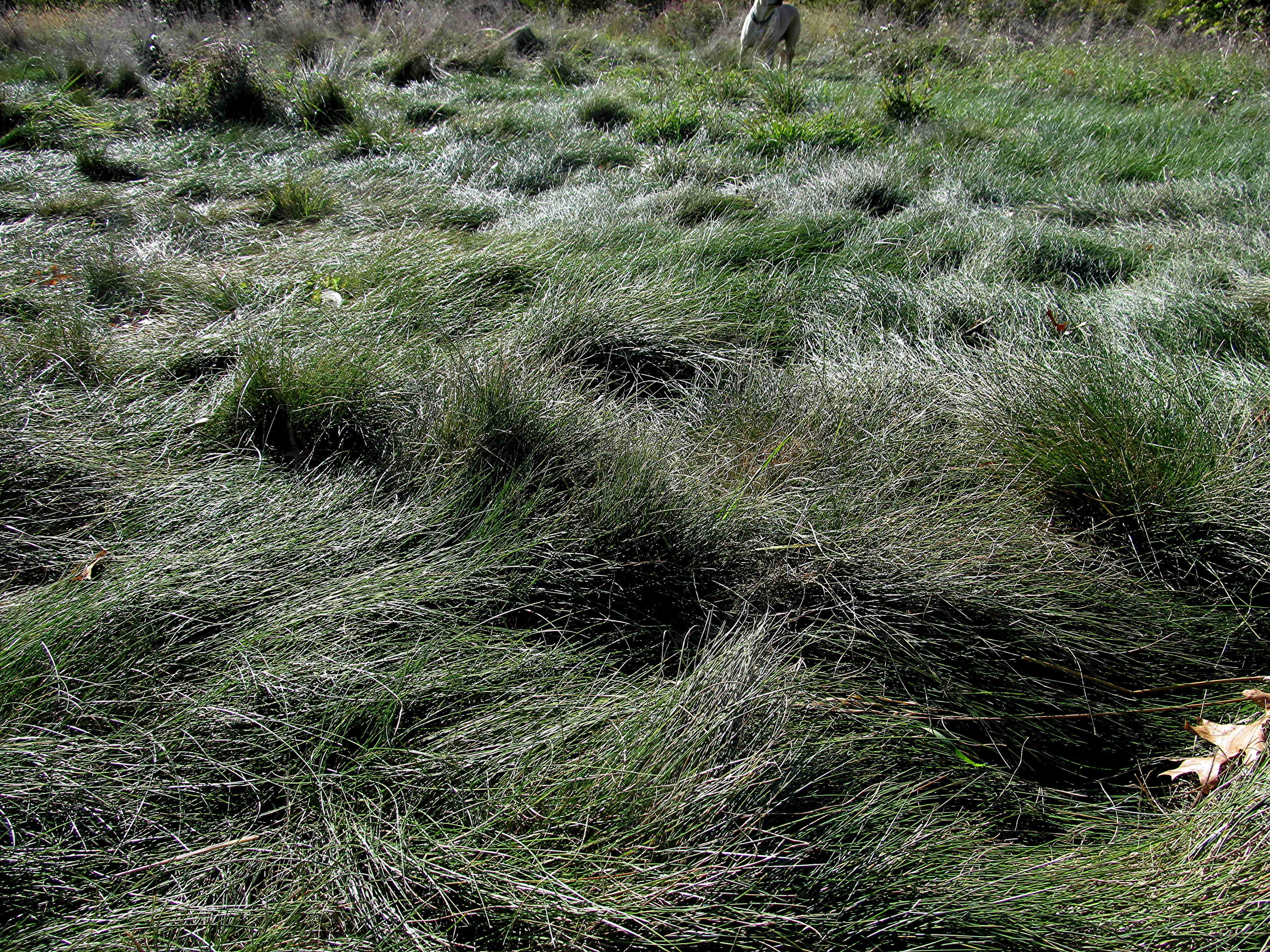 Creeping red fescue, tolerant of less water than other lawns, can also be grown as an informal meadow. Mow once or twice a year, then let it grow. Great for kids and dogs!
Creeping red fescue, tolerant of less water than other lawns, can also be grown as an informal meadow. Mow once or twice a year, then let it grow. Great for kids and dogs!
 Spanish lavender is an easy garden plant. This Arboretum All-Star earned its place on their list with a long season of bloom, from spring into summer. Not fragrant like the better-known lavenders, but each flower is showier and the bloom is more abundant. Very tolerant of low water.
Spanish lavender is an easy garden plant. This Arboretum All-Star earned its place on their list with a long season of bloom, from spring into summer. Not fragrant like the better-known lavenders, but each flower is showier and the bloom is more abundant. Very tolerant of low water.
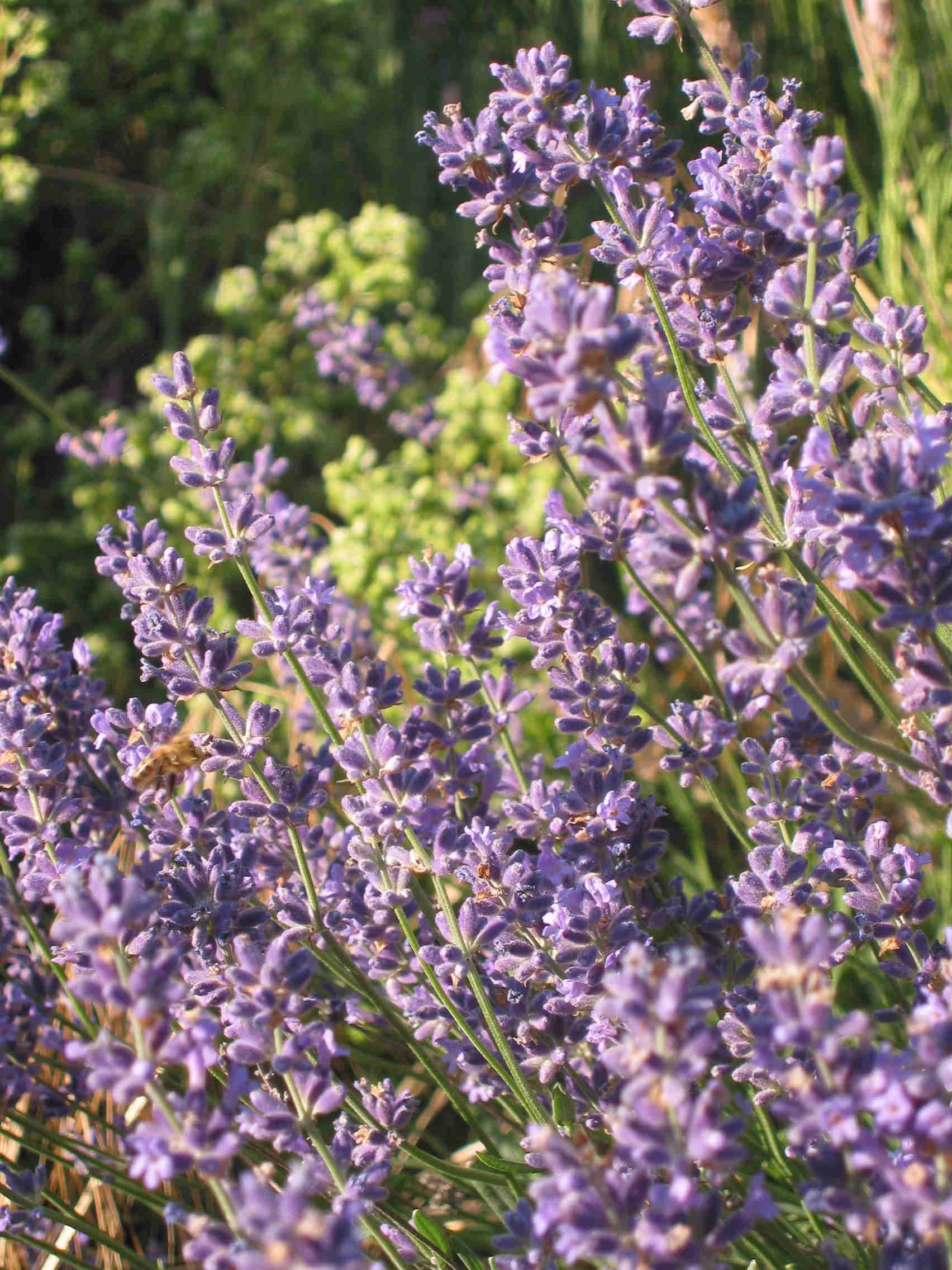 Provence (shown) and Grosso varieties are two of the regular lavenders grown for sachets and potpourris. Shrubs to 3 to 4 feet tall and wide, they can take full sun, infrequent watering. Bloom season is mostly May through July, with scattered blooms all the way into fall.
Provence (shown) and Grosso varieties are two of the regular lavenders grown for sachets and potpourris. Shrubs to 3 to 4 feet tall and wide, they can take full sun, infrequent watering. Bloom season is mostly May through July, with scattered blooms all the way into fall.
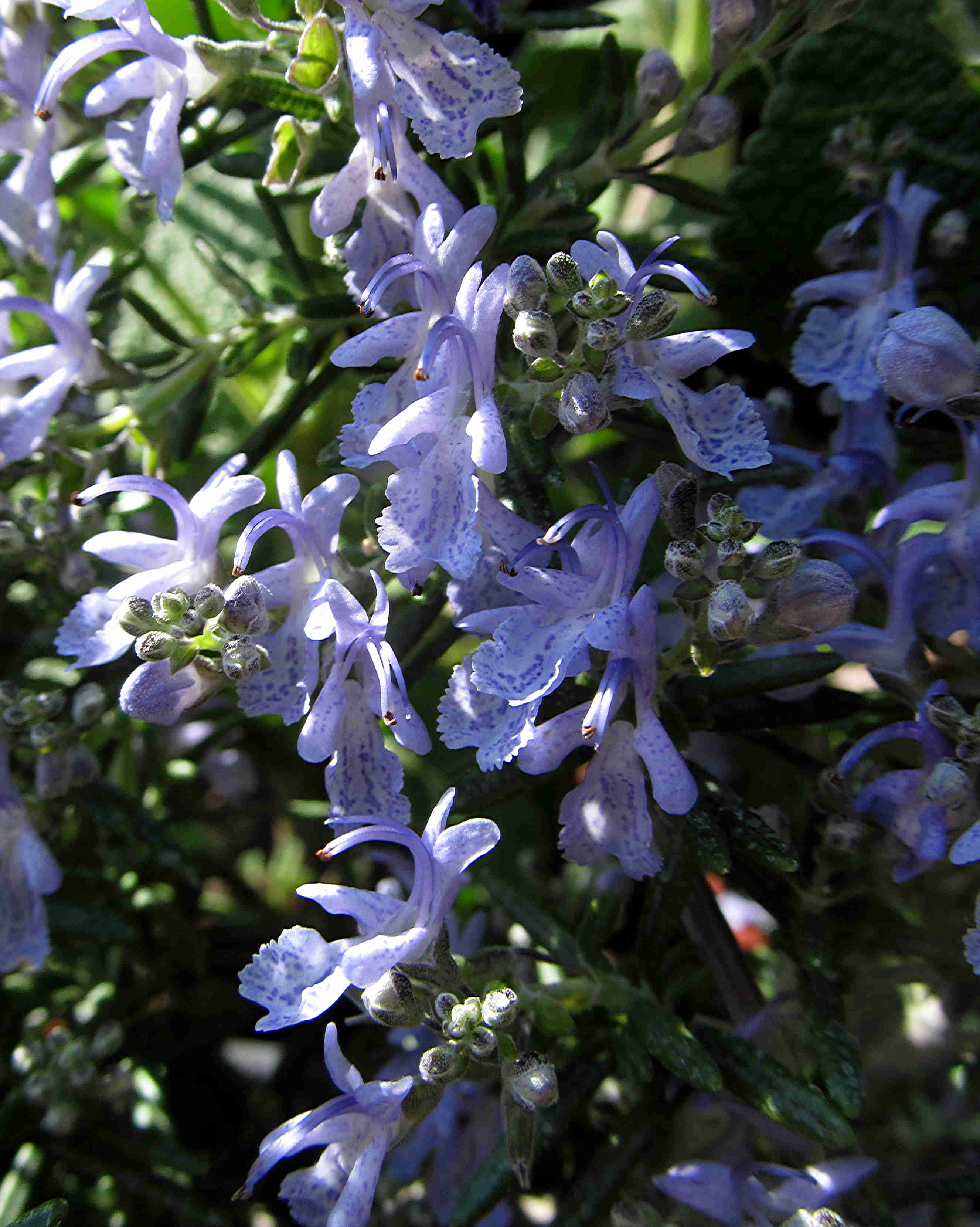 The shrubs you choose can be pretty and utilitarian as well as drought tolerant. Rosemary starts blooming in fall and continues through winter and into early spring, with varieties ranging from light to dark blue. Upright, trailing, and semi-trailing forms are available.
The shrubs you choose can be pretty and utilitarian as well as drought tolerant. Rosemary starts blooming in fall and continues through winter and into early spring, with varieties ranging from light to dark blue. Upright, trailing, and semi-trailing forms are available.
 Looking for a low-water lawn alternative? Succulents can thrive with water less than half as often as a lawn. Shown here is the variegated Dragon's blood stonecrop (Sedum).
Looking for a low-water lawn alternative? Succulents can thrive with water less than half as often as a lawn. Shown here is the variegated Dragon's blood stonecrop (Sedum).
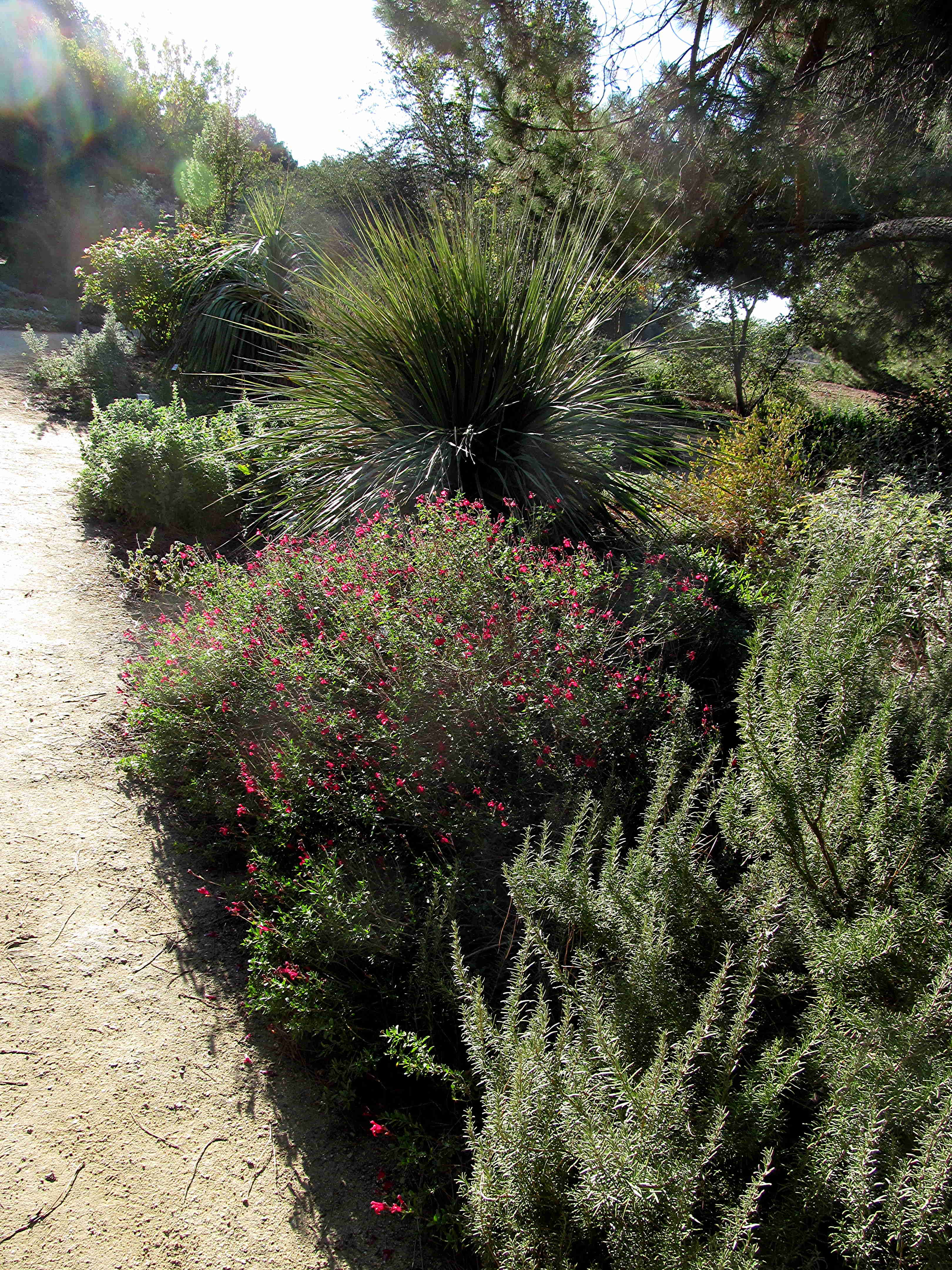 A sunny path in late afternoon in the Ruth Storer garden at the west end of the arboretum. The red salvias bloom heavily from late summer until frost. Rosemary in the foreground starts blooming in fall and continues through winter. The large ornamental grass provides a great accent.
A sunny path in late afternoon in the Ruth Storer garden at the west end of the arboretum. The red salvias bloom heavily from late summer until frost. Rosemary in the foreground starts blooming in fall and continues through winter. The large ornamental grass provides a great accent.
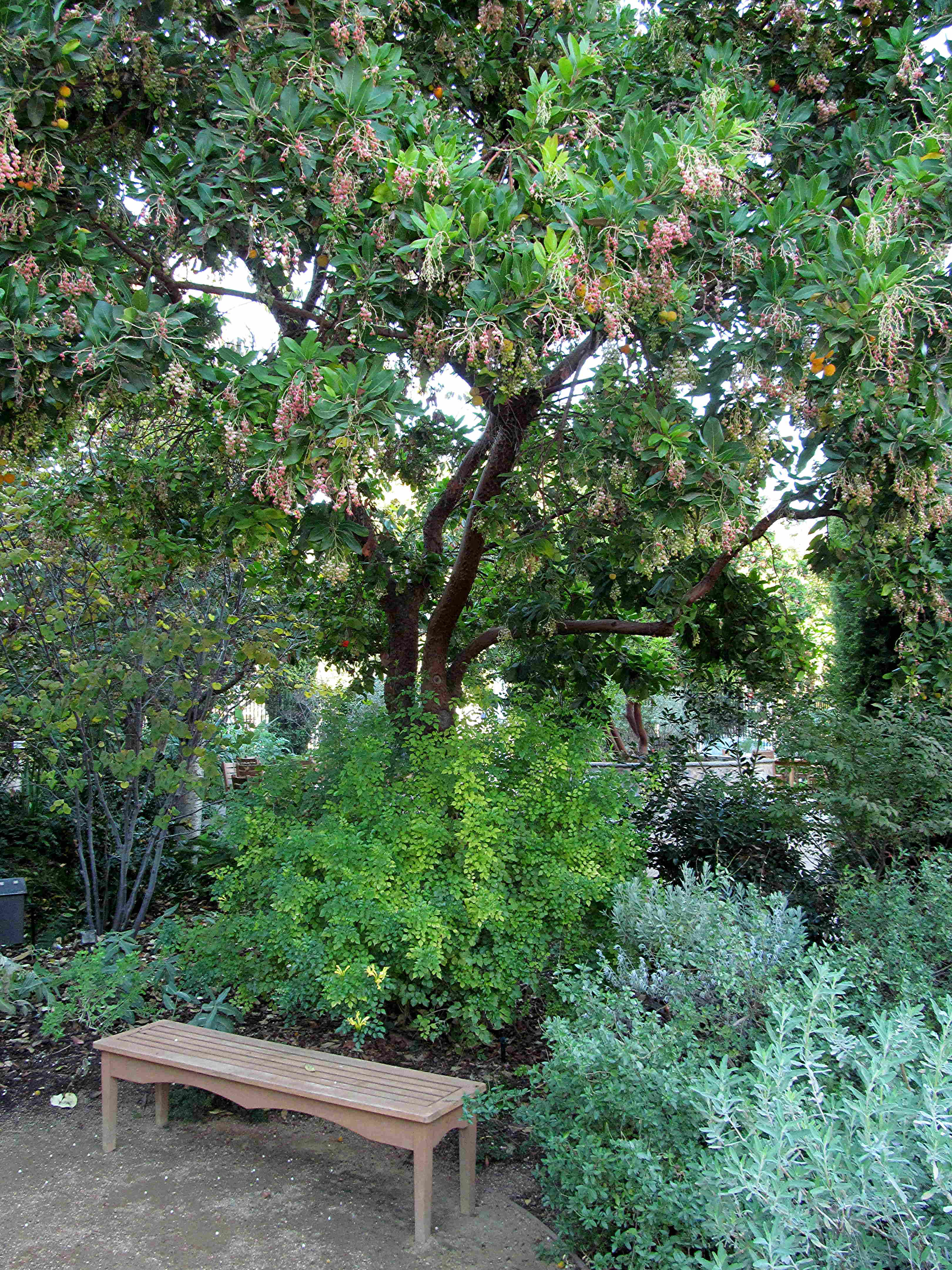 A shady nook in the Terrace Garden at the east end of the Arboretum. Shade here is cast by an Arbutus variety called Marina, a madrone relative with mahogany-colored bark, small pretty flowers over a long season (second picture), and a small crop of ornamental orange berries.
A shady nook in the Terrace Garden at the east end of the Arboretum. Shade here is cast by an Arbutus variety called Marina, a madrone relative with mahogany-colored bark, small pretty flowers over a long season (second picture), and a small crop of ornamental orange berries.
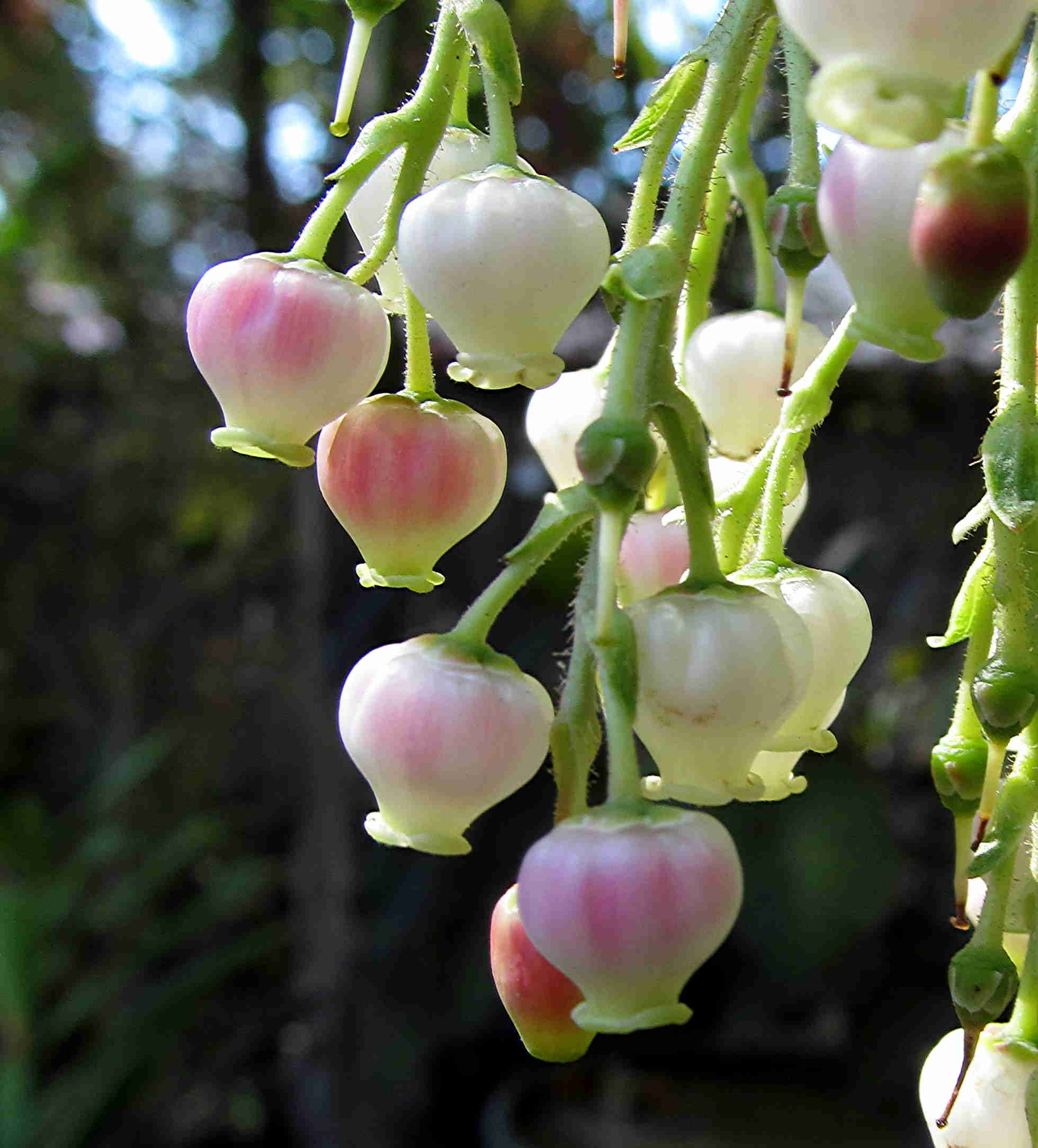 Close up of the flowers of Arbutus Marina.
Close up of the flowers of Arbutus Marina.
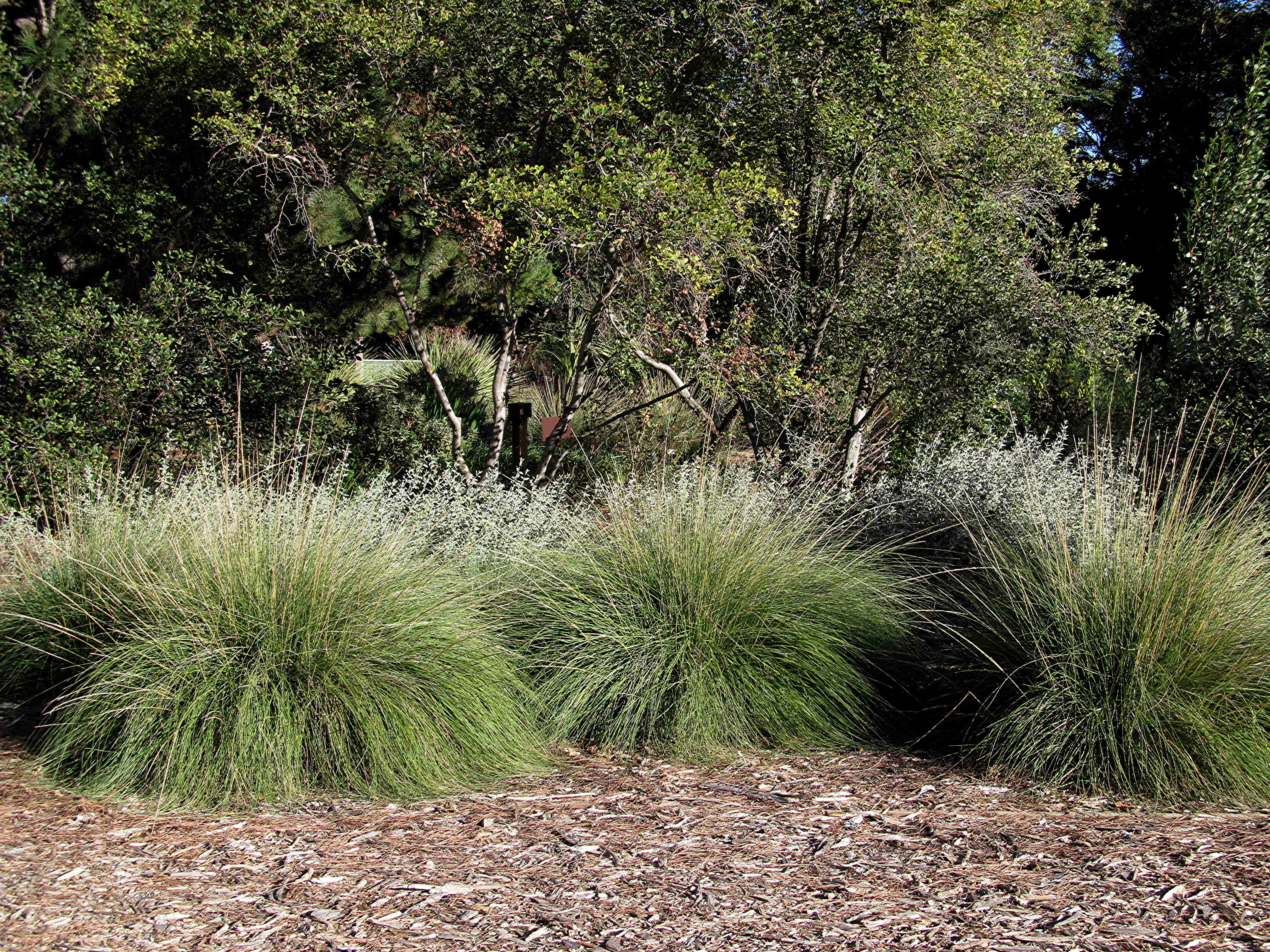 Ornamental grasses, used correctly, can be dramatic and attractive. Many get big! Each plant of Muhlenbergia, shown here, takes 3 feet of space. Use them as a bold accent at the back of the border, or as a complement along your meadow. Note the mulch in the foreground, to prevent weeds and conserve moisture.
Ornamental grasses, used correctly, can be dramatic and attractive. Many get big! Each plant of Muhlenbergia, shown here, takes 3 feet of space. Use them as a bold accent at the back of the border, or as a complement along your meadow. Note the mulch in the foreground, to prevent weeds and conserve moisture.
12 Tips For Reducing Water Use
1. First is to water right.
Water deeply and infrequently, typically no more than twice a week during the summer. Most established shrubs and trees can be watered thoroughly once every week or so. Most people could easily reduce their water use by 20% or more just by watering more deeply but less often.
When we ask about watering schedules, it is common to learn that shrubs are being watered 3 to 4 times a week. That's too often! And they're being watered for ten or fifteen minutes. That's not long enough!
2. Zone your plants by water need.
Some plants need more water: Japanese maples, hydrangeas, and ferns. You might want a lawn area. If you have a sprinkler timer, have these plants on their own valve and station.
3. Water thoroughly.
Shallow watering leads to shallow roots. Frequent watering leads to fungus problems. Sprinklers and drip watering systems that don't water evenly can lead to stress during hot spells, causing unsightly leaf burn.
However you water, you need to get the soil wet in the whole area where the plants are growing, and soak it to a depth of a foot or more. Then let the soil dry out before you water again. Good news: the clay loam soils typical in our area store water for several days.
4. Mulch well, mulch wisely.
Bare soil areas can be covered with two to four inches of compost or bark to help the soil retain moisture. Earthworms will feed on the mulch, soil microorganisms will decompose it, all of which helps build better soil. Just make sure the mulch isn't up against the bark of shrubs or trees, else it might trap moisture and cause crown rot. Just keep a few inches bare around your landscape plants.
Fall leaves make great mulch! Don't send them to the landfill! Spread them out over your vegetable garden or orchard. Decomposing leaves help create loamy soil.
5. Water your fruit trees like an orchard!
Fruit trees especially prefer deep, fairly infrequent soakings, so they are great for low water landscapes. Orchards are typically flooded, or watered with micro-sprinklers for many hours at a time, at long intervals. You can water established fruit trees every couple of weeks in the summer here.
A few types can tolerate considerable or total drought once established, including citrus, figs, jujube, persimmons, pineapple guava, pomegranates, and quince.
6. Reduce your lawn area.
Lawns are the biggest landscape water users, about a gallon per square foot each week. Many people apply more than that!
We like lawns for kids and dogs, and to help cool the part of the yard where we're active. But often lawns are planted where they're just for show. Put turf where you will use it, not just where you'll look at it.
7. Think about a "Smart timer."
These high-tech timers log in to weather stations to determine how much water to apply. If you have a large lawn with multiple valves, one of these timers could probably save you money in the long run.
You could monitor evapotranspiration rates and adjust your sprinklers accordingly. This may be intuitive: if it's cooler than average for the time of year, cut how long your sprinklers run a bit, or skip a watering cycle now and then.
If you do that, or if you don't happen to have a sprinkler system, just keep an eye on your lawn. Poke a trowel into the soil and assess the moisture. If it is looking duller green than usual, it is probably water stressed. If it doesn't spring back when you walk across it, it's definitely stressed.
8. Change your type of grass.
In new neighborhoods, you probably already have the lower-water tall or dwarf fescues. But old neighborhoods have blends of ryegrass and bluegrass, which are higher water users. Tall and dwarf fescues can take 20% less water than those older types, so changing over your turf can yield immediate savings.
Even better are the fine fescues such as creeping red or chewings fescue. More tolerant of shade as well, they can take 20% less water than the tall and dwarf fescues. We should all be using these fine fescues more.
With all fescue lawns, it is very important to mow them high: fescues have a high growing point. If you cut them too short, especially in hot weather, the lawn may thin out. Mow at three inches if possible.
9. Rethink your lawn: consider a meadow.
Fine fescue makes a very attractive informal groundcover when left unmowed. Or look into some of the other ornamental and native grass options. The UC Davis Arboretum is establishing a large area of Blue grama (Bouteloua gracilis), a California native grass, in a meadow near the oak grove at the west end.
10. Choose plants that use less water.
Ground covering plants can replace your lawn and use less water. Good choices include Mediterranean plants, natives of South Africa and Australia, California natives, and more.
For the backbone of your yard, choose shrubs that can live with reduced watering.
Here is a list of some shrubs that could be watered as little as once a month once established (which means after the first summer).
Blue mist spiraea (Caryopteris clandonensis)
Breath of heaven (Coleonema)
Butterfly bush (Buddleia)
Germander (Teucrium species)
Golden bush daisy (Euryops pectinatus)
Lavender (Lavandula species)
Myrtle (Myrtus communis)
dwarf Olive (Olea Little Ollie)
Rockrose (Cistus species)
Sages (Salvia species and hybrids)
Wild lilac (Ceanothus species and hybrids)
Here are some trees that can grow with very little water once established. I have seen some of these with no summer irrigation once established.
Atlas cedar (Cedrus atlantica)
Bay laurel (Laurus nobilis)
Desert willow (Chilopsis linearis)
Chaste tree (Vitex agnus-castus)
Chinese pistache (Pistacia chinensis)
Incense cedar (Calocedrus decurrens)
Purple smoke bush (Cotinus coggygria)
Shiny xylosma (Xylosma congestum)
Valley oak (Quercus lobata)
Note: 'once established' means that you DO need to water new trees every few days through at least their first summer. Water thoroughly, and make sure the surrounding soil gets a good soaking. Check that your system distributes water over the whole root system, or water by hand.
11. Consider California and southwestern native plants.
Some natives have special requirements for drainage, and some are vulnerable to rot, but others are adaptable to a range of garden situations. See our November 2012 column for suggestions.
12. Think local
The UC Davis Arboretum is a great resource for selecting plants for low water landscapes. Three gardens stand out for home gardeners looking for ideas. The Ruth Risdon Storer Garden is at the far west end of the Arboretum, street side of the gazebo. It is filled with natives, ornamental grasses, succulents and shrubs, and tough landscape roses, planted along meandering paths. There's color and seasonal interest every month of the year. The Storer garden blends into the Carolee Shields White Flower Garden. Nearby is the Arboretum Teaching Nursery, where recent landscaping improvements provide additional examples for home gardeners.
At the far east end of the Arboretum, nestled next to the new Whole Foods store, is the Arboretum Terrace Garden and Lois Crowe Patio. Areas of sun and shade, with comfortable sitting nooks, this is a wonderful mix of planters, shrubs, flowering perennials, bold accent plants, and more.
Arboretum All-Stars, many of which are growing and labeled in these gardens, are great starting points as you choose plants for a landscape you're creating or renovating. You can find the list online at http://arboretum.ucdavis.edu. Local nurseries and garden supply stores carry many of them, and have related plants that may be equally suitable.
Bonus tip: Don't forget succulents!
The original drought-tolerant plants for California gardens, they come in interesting colors and textures, use very low water, and are very carefree.
written for the Davis Enterprise, November 18 2012
